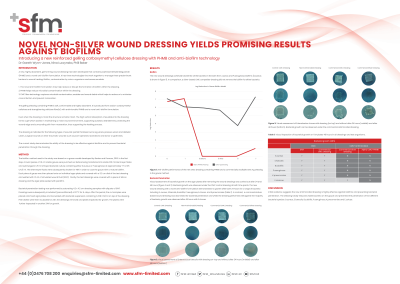Laboratory Research
(LR-056) A new, non-silver wound dressing has demonstrated promising early results with effectiveness against biofilms and preventing bacterial penetration in-vitro.
Friday, April 28, 2023
7:15 PM - 8:30 PM East Coast USA Time

Graeme Kettlewell, PhD – Director of Research and Development, R&D, Speciality Fibres and Materials Ltd
Introduction: A new, non-silver cellulose-based wound dressing has demonstrated to be effective against biofilms and preventing bacterial penetration. The fibres of the new dressing are coated with a novel antibiofilm formulation containing PHMB (polyhexanide).
Methods: The biofilm method used in the study was based on a gauze model developed by Bowler and Parsons, 2016. 1 In the first step, circular pieces of 1.6 cm sterile gauze were punched out before being transferred into sterile 100 ml Erlenmeyer flasks and submerged in 25 ml of liquid bacterial culture containing either S.aureus or P.aeruginosa at approximately 1-5 x 105 CFU/ ml. The Erlenmeyer flasks were subsequently shaken for 48h in order to coat the gauze with a mature biofilm.
Each piece of gauze was then placed onto an individual agar plate and covered with a 3.2 cm disk of the test dressing and wetted with 1.5 ml of simulated wound fluid. Finally, the test dressings were covered with a piece of silicon dressing and the plate closed with parafilm.
Bacterial penetration testing was performed by saturating 4.2 x 4.2 cm dressing samples with aliquots of SWF. Dressings were subsequently incubated (pre-conditioned) at 37°C for 6-days. After this period, the cut samples were placed onto fresh agar plates and inoculated with bacterial suspension containing 1x 108 CFU/ml evenly around the edge of the dressing. Petri dishes were then incubated for 24h, the dressings removed and plates inspected for growth.
Results: The new, non-silver wound dressings completely killed all the bacteria in the both the S. aureus and P.aeruginosa biofilms. In comparison, a silver based competitor dressing did not remove the biofilm for either bacteria.
Bacterial penetration was also prevented in the new dressing.
Discussion: Initial evidence would suggest the new non-silver dressing is highly effective against biofilms and preventing bacterial penetration.
Methods: The biofilm method used in the study was based on a gauze model developed by Bowler and Parsons, 2016. 1 In the first step, circular pieces of 1.6 cm sterile gauze were punched out before being transferred into sterile 100 ml Erlenmeyer flasks and submerged in 25 ml of liquid bacterial culture containing either S.aureus or P.aeruginosa at approximately 1-5 x 105 CFU/ ml. The Erlenmeyer flasks were subsequently shaken for 48h in order to coat the gauze with a mature biofilm.
Each piece of gauze was then placed onto an individual agar plate and covered with a 3.2 cm disk of the test dressing and wetted with 1.5 ml of simulated wound fluid. Finally, the test dressings were covered with a piece of silicon dressing and the plate closed with parafilm.
Bacterial penetration testing was performed by saturating 4.2 x 4.2 cm dressing samples with aliquots of SWF. Dressings were subsequently incubated (pre-conditioned) at 37°C for 6-days. After this period, the cut samples were placed onto fresh agar plates and inoculated with bacterial suspension containing 1x 108 CFU/ml evenly around the edge of the dressing. Petri dishes were then incubated for 24h, the dressings removed and plates inspected for growth.
Results: The new, non-silver wound dressings completely killed all the bacteria in the both the S. aureus and P.aeruginosa biofilms. In comparison, a silver based competitor dressing did not remove the biofilm for either bacteria.
Bacterial penetration was also prevented in the new dressing.
Discussion: Initial evidence would suggest the new non-silver dressing is highly effective against biofilms and preventing bacterial penetration.

.png)